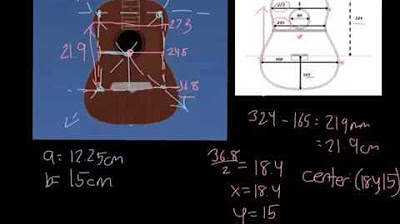Hyperbola by Foci and Vertices Method | Engineering Curves | Engineering Drawing | Engineering Funda
Summary
TLDRIn this video, the instructor explains how to trace a hyperbola using the foci and vertices method in engineering drawing. The problem involves plotting a curve based on the fixed points F1 and F2, with a constant distance difference between the moving point P and these points. Step-by-step instructions are provided for drawing arcs with a compass, using specific radii for the points, and marking key intersections to trace the hyperbola. The final smooth curve represents the hyperbola, with a focus on highlighting the darkened curve in the examination.
Takeaways
- 📐 The focus of this video is on explaining the foci and vertices method for drawing a hyperbola.
- 📏 The distance between two fixed points F1 and F2 is given as 80 mm.
- ✏️ Point P moves such that the difference between its distances from F1 and F2 is always 48 mm, forming a hyperbola.
- 🗺️ The method starts by drawing F1 and F2 with a 40 mm distance from the center point O on both sides.
- 🔄 Random points are selected on both sides of F1 and F2 to help trace the hyperbola curve.
- 🧭 The arc method involves using a compass to draw arcs from F1 and F2 with different radii based on the distance between the foci and randomly selected points.
- 📏 Each intersection of arcs creates points P1, P2, and P3 which help in forming the curve.
- 💡 The final hyperbola is drawn as a smooth curve passing through these points P1, P2, and P3.
- 🖋️ Only the hyperbolic curve needs to be darkened in the drawing, with all other lines remaining light.
- 👍 The video concludes by noting that this is one of the easiest methods for drawing a hyperbola.
Q & A
What is the primary focus of this video?
-The video focuses on explaining the foci and vertices method for drawing a hyperbola in engineering drawing.
What is the given distance between the two fixed points F1 and F2?
-The distance between the two fixed points F1 and F2 is 80 mm.
What is the significance of the moving point P in the hyperbola construction?
-The point P moves such that the difference between its distances from F1 and F2 is always constant and equal to 48 mm, which defines the shape of the hyperbola.
How do you mark points F1 and F2 on the horizontal line?
-You draw a horizontal line, choose a random center point O, and mark F1 and F2 at 40 mm to the left and right of O, respectively, ensuring the total distance between F1 and F2 is 80 mm.
What is the relationship between PF1 and PF2 in this problem?
-The difference between PF1 and PF2 is always constant, which is given as 48 mm. This corresponds to the distance between two points V1 and V2, which is 48 mm.
How do you set up the arcs needed to trace the hyperbola?
-You set the compass to different radii, first drawing arcs from F2 using radius V2A, then from F1 using radius V1A. You repeat this process with different radii for points B and C to trace the hyperbola.
What is the purpose of marking random points A, B, and C on the right of F2 and 1, 2, 3 on the left of F1?
-These points help in dividing the distances approximately equally to trace the arc and determine key points on the hyperbola during the construction process.
What steps are followed after drawing the arcs with the compass?
-After drawing the arcs with F1 and F2 as centers, the intersection points are marked as P1, P2, P3, which represent points on the hyperbola. A smooth curve is then drawn through these points to form the hyperbola.
How do you ensure that the hyperbola curve is accurate?
-The curve must pass smoothly through all the intersection points, and it should be carefully traced to ensure it follows the hyperbolic shape. The curve is darkened while the rest of the construction lines are kept light.
What advice does the instructor give for presenting the hyperbola in an examination?
-The instructor advises that only the hyperbola should be darkened in the final drawing, while the construction lines and auxiliary points should be kept as light as possible.
Outlines

Esta sección está disponible solo para usuarios con suscripción. Por favor, mejora tu plan para acceder a esta parte.
Mejorar ahoraMindmap

Esta sección está disponible solo para usuarios con suscripción. Por favor, mejora tu plan para acceder a esta parte.
Mejorar ahoraKeywords

Esta sección está disponible solo para usuarios con suscripción. Por favor, mejora tu plan para acceder a esta parte.
Mejorar ahoraHighlights

Esta sección está disponible solo para usuarios con suscripción. Por favor, mejora tu plan para acceder a esta parte.
Mejorar ahoraTranscripts

Esta sección está disponible solo para usuarios con suscripción. Por favor, mejora tu plan para acceder a esta parte.
Mejorar ahoraVer Más Videos Relacionados

Graphing Conic Sections Part 4: Hyperbolas

Hyperbola

Gráfica y elementos de la Elipse conociendo la ecuación canónica | Ejemplo 2

Procedural Generation Tutorial 1 - Planes

Irisan Kerucut - Hiperbola • Part 16: Persamaan Garis Singgung di Suatu Titik di Luar Hiperbola

INTRODUCTION OF HYPERBOLA || PRE-CALCULUS 2
5.0 / 5 (0 votes)
